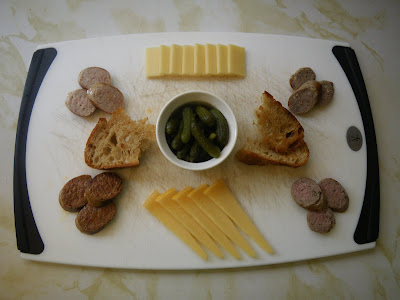After making the sausages, there were some very notable bits of ducky goodness left over. Their preparations are detailed below.
The carcasses. Of the many applications for duck stock (soups, sauces, braises...) all I could think of was making gravy to be ladled over duck poutine: potatoes, fried in duck fat, with chunks of foie gras. The worst kind of extravagance. But I want to try it. Badly.
I made a fairly standard stock. For some reason the colour of the finished product was off. Very off, actually: a greenish grey. I have no idea why this happened. I even blanched the bones before I started. It tasted fine, though.
 The fat. It's remarkable how much fat can be rendered from duck scraps. I put my trimmings in a large pot with a bit of water and set it over very, very low heat. After several hours I strained. Cooled to room temperature, the fat separated into three distinct layers. The top most, and by far the most voluminous, was golden, liquid duck fat. The next layer down was light brown and solid. The bottom layer was white and solid. I don't know exactly what these were. The white layer was probably some kind of impurity, and the brown layer its caramelized cousin. The yellow duck fat, being liquid, was easily separated.
The fat. It's remarkable how much fat can be rendered from duck scraps. I put my trimmings in a large pot with a bit of water and set it over very, very low heat. After several hours I strained. Cooled to room temperature, the fat separated into three distinct layers. The top most, and by far the most voluminous, was golden, liquid duck fat. The next layer down was light brown and solid. The bottom layer was white and solid. I don't know exactly what these were. The white layer was probably some kind of impurity, and the brown layer its caramelized cousin. The yellow duck fat, being liquid, was easily separated.Two legs. Planets aligned. I had in my kitchen everything I needed to make confit of duck leg: copious duck fat, duck legs, a ceramic pot.
Confit is a French word that means "preserve". It generally refers to a specific method of preserving: meat, usually duck or goose, is completely submerged in fat (usually duck, goose, or pork) and is cooked very gently for several hours. The meat is then cooled, still in its pot, still covered in fat, and can then be stored for several months. To eat, the meat is dug out of the fat and heated. Usually seared so that it has a nice crispy exterior. The most common cut of meat to be "confited" is leg of duck.First I covered the legs with kosher salt, cracked black peppercorns, crushed whole cloves, broken bay leaves, and slivers of garlic. I covered with plastic wrap and let sit two days.
Next I completely covered the legs with duck fat, and threw them in a 180F oven.
Then Lisa came home from work and, not realizing the oven was already in use, preheated the oven to 400F. When I next checked my duck legs they were bubbling violently. I took a long, treacherous goat path to make deep-fried duck.
Was the resulting product confit? No. Was it absolutely delicious? Yes. Go figure duck legs deep-fried in duck fat taste amazing. One leg was shredded and eaten on crostinis with herb mayo and deep fried sage leaves. The other was eaten with bread and grainy mustard.





